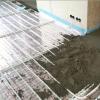Flushing of engineering systems
Rusty dirty pipes can not only cause violations of thermal and hydraulic regimes, but also a source of drinking water pollution. Internal fouling of pipes helps to reduce the "live" (flow) section and can lead to complete blockage and stop the flow of water to the points of water intake. Flushing the water supply system is an event that will prevent these problems and significantly increase the life of the entire system. If preventive work is ignored, in the end this will lead to the need to replace pipes, which in some cases is accompanied by the dismantling of the structure and its subsequent restoration.
The sure signs that the water supply and sewerage of a private house are clogged are the appearance of an unpleasant odor. Clogged water pipes are indicated by the appearance of rust flakes, a metallic taste, and a change in the color of the water. If the flushing of the hot water supply system using metal pipes was not carried out in a timely manner, this will not only reduce their throughput, but also negatively affect the circulation of the resource. The result will be an increase in energy consumption to ensure the optimum temperature, as well as an increased consumption rate.
Flushing water pipes - main types
The most common cause of fouling on the inner surface of pipes is corrosion processes, as well as pollution caused by unfiltered water. Flushing the water supply system can be of the following types:
- hydrodynamic. It consists in removing scale and blockages from pipes by cleaning the system with thin jets of water, which are supplied under high pressure through special nozzles. This type of cleaning allows you to achieve high results at a relatively low cost. Hydrodynamic flushing of the system will cost half as much as replacing water supply pipes. Thanks to the operation of hydrodynamic cleaning devices, magnesium, sodium, calcium salts, fats, rust, scale are completely removed from the pipes.
instruction - Hydrodynamic flushing of pipes
- hydrochemical flushing is one of the most common non-separable flushing methods water supply and heating systems, which allows you to transfer deposits and scale into a dissolved state and wash them out of the system. Chemical flushing of the water supply system uses products that are approved for use by sanitary and epidemiological supervision. This guarantees their complete safety in relation to pipelines and water heating equipment. Such reagents act only on scale and rust. For flushing the heating system, alkaline and acidic solutions of reagents are used. For example, composite inorganic and organic acids (compositions based on caustic soda, phosphoric acid, solutions with various additives, etc.). The exact composition of a particular flushing agent is kept secret by manufacturers.

Chemical flushing of the water supply system is a reliable and economical method that allows you to clean the system of dirt and scale. With its help, a positive result is quickly achieved. In one cycle, it is possible to flush not only the DHW system (hot water supply), but cold water supply, sewerage, heating system, clean heating equipment (DHW boilers and boilers).
- Pneumohydropulse flushing of water supply pipes. This cleaning method allows you to flush the system by multiple pulses that are transmitted using a special apparatus. Under the action of a kinetic impulse wave, cavitation bubbles are created in the liquid filling the pipes, which have a high intensity during the discharge period. Receipt bubbles, moving with the flow of water towards the area of high pressure, as well as in the period of compression, burst, creating a shock wave. Under its action, deposits come off the walls of the pipes and the subsequent wave carries them away.

The hot water and heating system is much easier to flush than the rest. This is due to the design of the circuit, which is closed or closed. Therefore, all types of washing pass here easily and painlessly. It is better to flush the sewerage system chemically, as it is considered non-pressure, and, therefore, the presence of high pressure can damage pipelines and their connections. The cold water supply system can be flushed with any of the options listed. But at the same time, it is necessary to completely cut off the network from external influence (source, equipment or central backbone). It is also recommended to leave one of the water points open so that all plaque and rust can freely exit the pipelines.
http://aquagroup.ru


